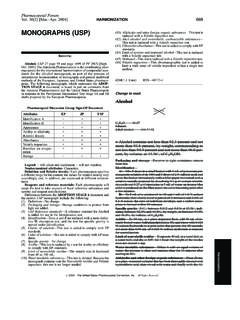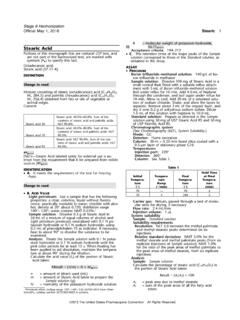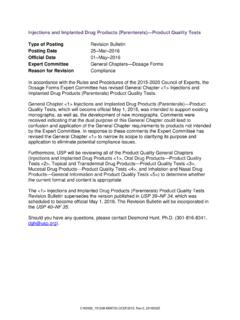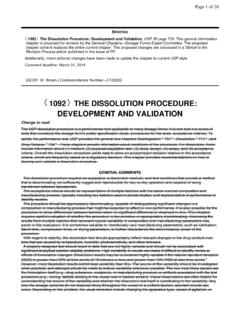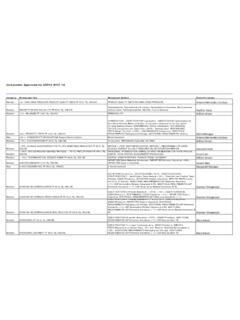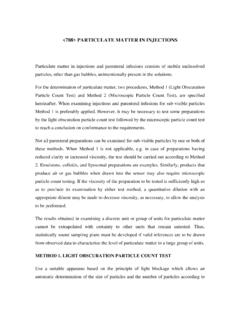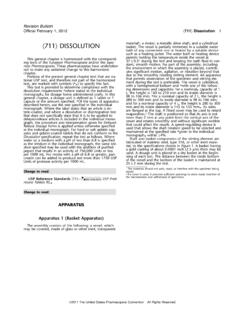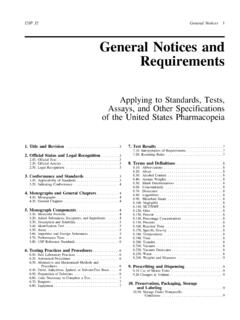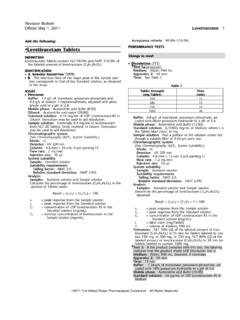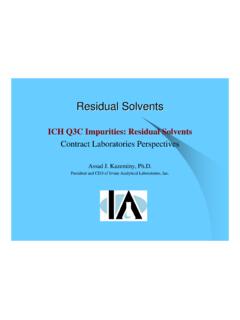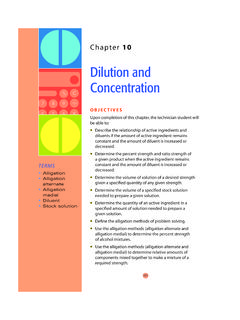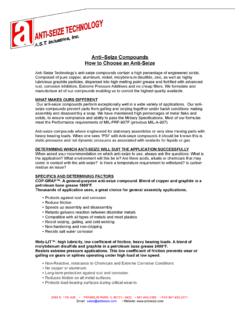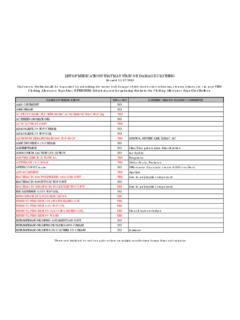Transcription of Topical and Transdermal Drug Products - USP-NF
1 Topical and Transdermal drug ProductsThe Topical / Transdermal Ad Hoc Advisory Panel for the USP Performance Tests of Topical and Transdermal Dosage Forms:Clarence T. Ueda (Chair), Vinod P. Shah (USP Scientific Liaison), Kris Derdzinski, Gary Ewing, Gordon Flynn, Howard Maibach,Margareth Marques (USP Scientific Liaison),aHoward Rytting,bSteve Shaw, Kailas Thakker, and Avi provides general information about the test methods that should be employed toensure the quality and performance of Topical and Transdermal drug Products . The termtopical drug productsrefers toall formulations applied to the skin except Transdermal delivery systems (TDS) or Transdermal patches that will beaddressed Products topically administered via the skin fallinto two general categories, those applied for local actionand those for systemic effects. Local actions includethose at or on the surface of the skin, those that exerttheir actions on the stratum corneum, and those thatmodulate the function of the epidermis and/or the der-mis.
2 Common Products in the former category includecreams, gels, ointments, pastes, suspensions, lotions,foams, sprays, aerosols, and solutions. Creams, oint-ments, and gels generally are referred to as semisoliddosage forms. The most common drug Products appliedto the skin for systemic effects are referred to as self-adhering Transdermal drug delivery systems (TDS) ortransdermal categories of tests, product quality tests and prod-uct performance tests, are performed with drug productsto provide assurances of batch-to-batch quality, reprodu-cibility, reliability, and performance. product quality testsare performed to assess attributes such as assay, identifi-cation, content uniformity, pH, microbial limits, andminimum fill and are part of the compendial mono-graph. product performance tests are conducted to as-sess drug release from the finished dosage provides general information aboutthe test methods that should be employed to ensure thequality and performance of Topical and Transdermal drugproducts.
3 The termtopical drug productsrefers to all for-mulations applied to the skin except Transdermal deliverysystems (TDS) or Transdermal patches that will be ad-dressed dosage forms include solutions (for which re-lease testing is not indicated), collodion, suspensions,emulsions ( , lotions), semisolids ( , foams, oint-ments, pastes, creams, and gels), solids ( , powdersand aerosols), and sprays. The physical characteristicsof these dosage forms vary , the in vitro release test for those productsalso may differ significantly and may require differenttypes of apparatus. At present, a product performancetest exists only for semisolidformulations, specificallycreams, ointments, and gels. That test employs the ver-tical diffusion cell (VDC) system. The VDC system is sim-ple to operate and yields reliable and reproducible resultswhen employed by properly trained laboratory or Transdermal patches are physical devices ap-plied to the skin and vary in their composition and meth-od of fabrication.
4 Therefore, they release their activeingredients by different OF TERMSD efinitions of Topical drug Products , some aspects re-lated to the manufacture of these Products , and a glos-sary of dosage form names commonly used can be foundin General Information ChapterPharmaceutical (pyroxylin solution; seeUSPmonograph), isa solution of nitrocellulose in ether and acetone, some-times with the addition of alcohol. As the volatile solventsevaporate, a dry celluloid-like film is left on the skin. Be-cause the medicinal use of a collodion depends on theformation of a protective film, the film should be durable,tenacious in adherence, flexible, and are semisolid dosage forms that contain one ormore drug substances dissolved or dispersed in a suitablebase. This term traditionally has been applied to semi-solids that possess a relatively soft, spreadable consis-tency formulated as either water-in-oil or oil-in-wateremulsions. However, more recently the term has been re-stricted to Products consisting of oil-in-water emulsionsor aqueous microcrystalline dispersions of long-chainfatty acids or alcohols that are water washable and morecosmetically and aesthetically should be addressed to: Margareth Marques, PhD,Senior Scientist, Documentary Standards Division, US PharmacopeialConvention, 12601 Twinbrook Parkway, Rockville, MD 20852-1790;tel.
5 ; e-mail TO THE REVISION PROCESSP harmacopeial ForumStimuli articles do not necessarily reflect the policiesVol. 35(3) [May June 2009]of the USPC or the USP Council of Experts750#2009 The United States Pharmacopeial Convention, Rights to the Revision ProcessEmulsionsEmulsions are viscid, multiphase systems in which oneor more liquids are dispersed throughout another immis-cible liquid in the form of small droplets. When oil is thedispersed phase and an aqueous solution is the continu-ous phase, the system is designated as an oil-in-wateremulsion. Conversely, when water or an aqueous solu-tion is the dispersed phase and oil or oleaginous materialis the continuous phase, the system is designated as awater-in-oil emulsion. Emulsions are stabilized by emulsi-fying agents that prevent coalescence, the merging ofsmall droplets into larger droplets, and, ultimately, intoa single separated phase. Emulsifying agents (surfac-tants) act by concentrating at the interface betweenthe immiscible liquids, thereby providing a physical bar-rier that reduces the tendency for coalescence.
6 Surfac-tants also reduce the interfacial tension between thephases, facilitating the formation of small droplets uponmixing. The term emulsion is not used if a more specificterm is applicable, , cream or are emulsified systems packaged in pressurizedcontainers or special dispensing devices that contain dis-persed gas bubbles, usually in a liquid continuous phase,that when dispensed has a fluffy, semisolid (sometimes called Jellies) are semisolid systemsconsisting of either suspensions composed of small inor-ganic particles or large organic molecules interpene-trated by a liquid. When the gel mass consists of anetwork of small discrete particles, the gel is classifiedas a two-phase system ( , Aluminum Hydroxide Gel,USP). In a two-phase system if the particle size of the dis-persed phase is relatively large, the gel mass is sometimesreferred to as a magma ( , Bentonite Magma,NF).Both gels and magmas may be thixotropic, formingsemisolids after standing and becoming liquid when agi-tated.
7 They should be shaken before use to ensure homo-geneity and should be labeled to that effect (see TopicalSuspensions, below). Single-phase gels consist of organicmacromolecules uniformly distributed throughout a liq-uid with no apparent boundary between the dispersedmacromolecule and the term lotion may be applied to a solution,lotions usually are fluid, somewhat viscid emulsiondosage forms for external application to the skin. Lotionsshare many characteristics with creams. See Creams, To-pical Solutions, and Topical Suspensions, are semisolids intended for external appli-cation to the skin or mucous membranes. They usuallycontain less than 20% water and volatiles and more than50% hydrocarbons, waxes, or polyols as the bases recognized for use as vehicles fall intofour general classes: hydrocarbon bases, absorptionbases, water-removable bases, and water-soluble therapeutic ointment possesses as its base one ofthese four general Bases Hydrocarbon bases, known alsoas oleaginous ointment bases, are represented byWhite petrolatum and White Ointment (bothUSP).
8 Onlysmall amounts of an aqueous component can be incor-porated into these bases. Hydrocarbon bases serve tokeep medicaments in prolonged contact with the skinand act as occlusive dressings. These bases are usedchiefly for their emollient effects and are difficult to washoff. They do not dry out or change noticeably Bases This class of bases may be dividedinto two groups: the first consists of bases that permitthe incorporation of aqueous solutions with the forma-tion of a water-in-oil emulsion ( , Hydrophilic Petrola-tum and Lanolin, bothUSP), and the second groupconsists of water-in-oil emulsions that permit the incor-poration of additional quantities of aqueous solutions(Lanolin,USP). Absorption bases also are useful Bases Water-removable bases areoil-in-water emulsions ( , Hydrophilic Ointment,USP), and are more correctly called creams (seeCreams, above). They also are described as water-wash-able because they may be readily washed from the skinor clothing with water, an attribute that makes themmore acceptable for cosmetic purposes.
9 Some medica-ments may be more effective in these bases than in hy-drocarbon bases. Other advantages of the water-removable bases are that they may be diluted with waterand that they favor the absorption of serous discharges indermatological Bases This group of so-called grease-less ointment bases comprises water-soluble constitu-ents. Polyethylene Glycol Ointment,NFis the onlypharmacopeial preparation in this group. Bases of thistype offer many of the advantages of the water-remova-ble bases and, in addition, contain no water-insolublesubstances such as petrolatum , anhydrous lanolin, orwaxes. They are more correctly called Gels (see Gels,above).Choice of Base Thechoiceofanointmentbasede-pends on many factors, such as the action desired, thenature of the medicament to be incorporated and itsbioavailability and stability, and the requisite shelf life ofthe finished product . In some cases, it is necessary to usea base that is less than ideal in order to achieve the sta-bility required.
10 Drugs that hydrolyze rapidly, for example,are more stable in hydrocarbon bases than in bases thatcontain water, even though they may be more effectivein the TO THE REVISION PROCESSP harmacopeial ForumStimuli articles do not necessarily reflect the policiesVol. 35(3) [May June 2009]of the USPC or the USP Council of Experts751#2009 The United States Pharmacopeial Convention, Rights to the Revision ProcessOphthalmic OintmentsOphthalmic ointments are semisolids for applicationto the eye. Special precautions must be taken in the prep-aration of ophthalmic ointments. They are manufacturedfrom sterilized ingredients under rigidly aseptic condi-tions, must meet the requirements underSterility Testsh71i, and must be free of large particles. The medicinalagent is added to the ointment base either as a solutionor as a micronized are semisolid dosage forms that contain a highpercentage (often 50%) of finely dispersed solids witha stiff consistency intended for Topical application.
